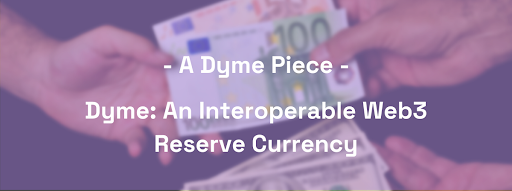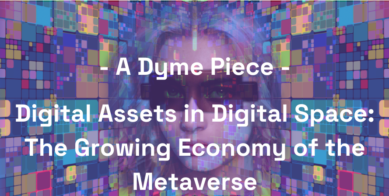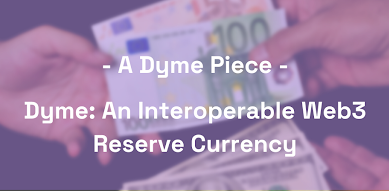Dyme is laying the social and financial groundwork for Web 3.0. As an evolution of the more centralized Web 2.0, Web 3.0 projects hold sway over massive existing and emerging growth industries. This unusual combination of industry size and growth gives rise to an opportunity for foundational elements of the emerging Web 3.0 space to avoid a zero-sum game scenario. By building these foundational elements of the decentralized internet through community development and self-determined governance, Dyme is positioned to serve as the common economic structure across Web 3.0.
This is where Dyme is positioned: by avoiding this zero-sum game scenario, the Dyme cryptocurrency can evolve into an egalitarian, decentralized entity with persistent, growing value. Further, the projects which adopt Dyme early will realize the most significant economic incentives without diminishing the positive economic potential for later entrants.
To achieve this, Dyme focuses on the three main areas necessary for a decentralized but standardized economic structure: democratic governance, decentralized management, and transparent economic structures and goals. These align with the aspirations of Web 3.0. Web3, the decentralized internet, is where users control their data, influence, and destiny.
Cosmos and Ignite: the right decentralized protocols for Dyme
Choosing the right blockchain to realize the Dyme thesis
Dyme is built using Ignite CLI (formerly Tendermint BFT) and the Cosmos SDK framework. By transforming a decentralized blockchain network structure into a generalized consensus engine, Ignite provides a platform for interoperable, sovereign decentralized networks that resembles the early days of the world wide web and the very first e-commerce transactions. When combined with the Cosmos SDK, Dyme has a platform to create the natural next step for the future of Web 3.0: a cross-network cryptocurrency, a decentralized but standardized economic engine for the decentralized internet.
As a sovereign public blockchain in the Cosmos ecosystem, Dyme aims to provide a robust toolset, use cases, and community support for deploying Dyme as a reserve cryptocurrency for Web 3.0 business models. At launch, Dyme will be a decentralized network serving as a censorship-resistant, decentralized, and permissionless means for creators and companies to manage their own native tokens with the benefit of democratic governance, decentralized management, and transparent economic structures and goals.
Responsibly shaping a new economic paradigm
Dyme joins many platforms using Cosmos to make the next generation of the world wide web a reality. From interchain smart contracts at Juno to a decentralized network to store data and create communities at Kira, from video streaming at Theta to equal access NFT crypto wallets at Monet, Cosmos and the Interchain Foundation have shepherded a range of decentralized autonomous organizations toward the future decentralized web.
Dyme views the work of the Interchain Foundation as similar to the IETF during the early days of NSFNet and the start of VoIP and the world wide web: as an enabler of technologies that support various services. From a decentralized storage network to distributed computing power to process transactions between two or more parties and share data across chains, Cosmos and the Interchain Foundation are elemental to a successful Web 3.0 ecosystem.
❓ What is Web 3.0?
Web 3.0: Semantic web meets world wide web
Web 3.0 is a term used to describe the evolution of the internet from an information-sharing platform to a platform for communication, collaboration, and commerce. The new advancements that have made this development possible include distributed ledger technology, cryptography, peer-to-peer networks, decentralized computing, smart contracts, and digital assets trading and management systems.
Cloud providers restrict access no more!
Web 3.0 represents a shift in power away from large, centralized organizations to more distributed ownership models by individuals and small groups. This gives users more data privacy and control over their information instead of relying on third parties. Web3 also allows users to transact faster and more securely than ever before. Additionally, users can access applications tailored to their specific needs rather than relying on general-purpose ones from large corporations. Web 3.0 is revolutionizing how we interact with the world around us through its decentralized infrastructure that promotes open access to information and global collaboration between individuals.
Users create content, companies create next-generation technologies
Web 3.0 stands in marked contrast to the highly centralized, powerfully oligarchic structure of Web 2.0, which has a range of large technology companies controlling the economy of the internet for their benefit. Web3 represents a return to the roots of the internet, where wealth was created through shared infrastructure, and common structures worked to elevate a wide range of companies and projects.
This return to the roots of the internet is seen in overlaps between the early world wide web and the more recent development of digital assets, smart contracts, decentralized apps, and other blockchain projects.
The read only generation gives way to the read write own generation
The business model of Web 3.0 is also different from Web 2.0, in that user content is owned by the user and not the property of cloud providers, current web services, or companies making up the current social web. The business models then provide more control to internet users but still make money by providing services and a new wave of useful technologies. Concisely, they move beyond the “read only” web from the 90s into a “read write execute” or a “read write own” model for the future.
Dyme’s thesis is this new wave of services will benefit from a decentralized but standardized economic engine for the decentralized internet.
🚀 Why does Web 3.0 need Dyme?
Data and transactions interwoven
There is a strong benefit for a common economic structure across Web 3.0. This is as true today as it was true during the creation of Web 2.0 when in 1999, the founder of X.com said on CBS MarketWatch that people were ready to use the Internet as their main financial repository.
The economic structure seen in Web 2.0 treats users like merchandise. In no area is this seen more clearly than with targeted ads. The entire computing power of Web 2.0 social networks is directed at monetizing user and user-generated content without adding to users’ bank accounts. This speaks to the need for a native token to put control back in the hands of users. Dyme addresses this need.
Controlled by users, managed by smart contracts
Users benefit as control shifts back from central authorities (specifically large technology companies) toward equal access and corporate censorship shifts toward censorship resistance. This benefit comes from freeing user-generated content from the highly centralized, powerfully oligarchic structure of Web 2.0, which has a range of massive corporations controlling the financial benefit of that content for their own gain.
As the semantic web supplants the Web 2.0 oligarchy, revisiting Musk’s “third stage” helps shift financial access and services from centralized control and supports users gaining financial benefit from their own content. Whether it makes money for users or provides various services in exchange for access to content, control puts the outcome of financial transactions in the hands of users.
Dyme as the enabling technology for community digital assets
Rather than a zero-sum game of winners and losers seen in Web 2.0, public blockchains and integrated blockchain networks can blend both the size of the existing Web 2.0 economy and the growth of the emerging Web 3.0 economy. This is where Dyme is positioned: by avoiding this zero-sum game scenario, the Dyme cryptocurrency can evolve into an egalitarian, decentralized entity with persistent, growing value.
To achieve this, Dyme focuses on the three main areas we believe are necessary for a decentralized but standardized economic structure: democratic governance, decentralized management, and transparent economic structures and goals. By building these foundational elements of decentralized services through community development and self-determined governance, Dyme is positioned to serve as the common economic structure across Web 3.0.
Further, the projects which adopt Dyme early will realize the most significant economic incentives without diminishing the positive economic potential for later entrants.
We will further address these topics in the near future.
👉 Social media platforms for Dyme
Developers, validators, and delegators, we want your active involvement in shaping the future of Dyme! Please join the official channels on Medium, Telegram, and Twitter. All ecosystem efforts are directed by community contributors.
- Web: https://dyme.336.thegrove.co
- Medium: https://www.medium.com/dyme-network/
- Twitter: https://twitter.com/DymeNetwork
- Facebook: https://www.facebook.com/DymeNetwork
- LinkedIn: https://www.linkedin.com/company/dyme/
- Telegram: https://t.me/dymenetwork
- Github: https://github.com/Dyme-Foundation
- Discord: TBD
About Dana:
Dr. Dana Love is currently the CTO of Lifetoken Software. Love is a 32-year technology veteran who has been active in bitcoin and blockchain since 2011. From 2018–22 Dr. Love founded and led the blockchain payment platform Radpay, where he was recognized as a fintech innovator by both 500 Startups and the Arizona Commerce Authority. From 2012–18 Dana spearheaded four different blockchain ICOs and led different enterprise leadership roles. From 2007–12, as CEO of military contractor Bright Dawn, Dana led the development of complex real-time data systems, big data and data fusion projects, and a variety of digital and kinetic work for the IC, Defense, and civilian agencies. From 1995–2007, Love founded or served in leadership for various firms, including Cisco Investments-backed Metacloud and Warburg Pincus-backed Radnet, and led divisions of public companies, including GTE (now Verizon), Prosodie (now Cap Gemini), and ADC. Dana’s career began in civilian service to the U.S. government. Dana Love holds a doctorate in public policy economics from the University of Glasgow, is a Harvard Business School Baker Scholar, and graduated from the University of Richmond.


